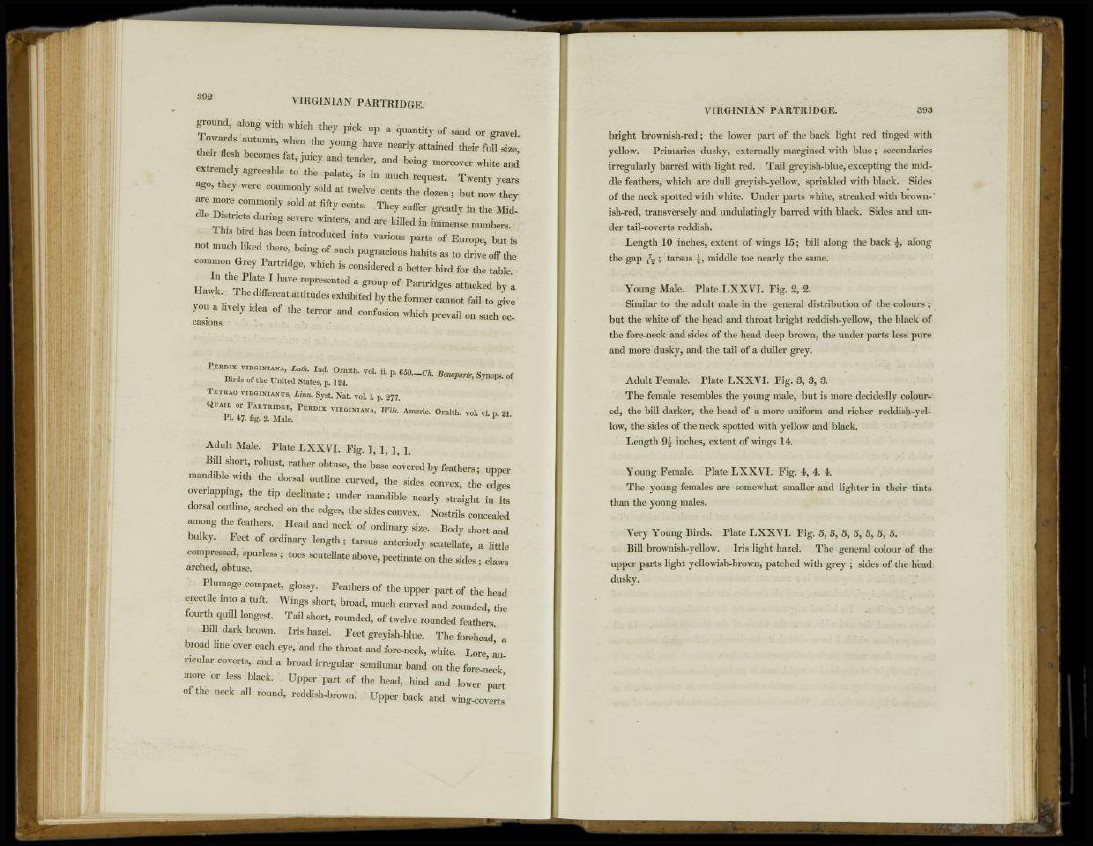
392 VIRGINIAN PARTRIDGE.
ground, along with which they pick up a quantity of sand or gravel.
Towards autumn, when the young have nearly attained their full size,
their flesh becomes fat, juicy and tender, and being moreover white and
extremely agreeable to the palate, is in much request. Twenty years
ago, they were commonly sold at twelve cents the dozen; but now they
are more commonly sold at fifty cents. They suffer greatly in the Middle
Districts during severe winters, and are killed in immense numbers.
This bird has been introduced into various parts of Europe, but is
not much liked there, being of such pugnacious habits as to drive off the
common Grey Partridge, which is considered a better bird for the table.
In the Plate I have represented a group of Partridges attacked by a
Hawk. The different attitudes exhibited by the former cannot fail to give
you a lively idea of the terror and confusion which prevail on such occasions.
PERDIX VIRGINIANA, Lath. Ind. Ornith. vol. ii. p. G50.—Ch. Bonaparte, Synops. of
Birds of the United States, p. 124.
TETRAO VIRGINIANUS, Linn. Syst. Nat. vol. i. p. 277.
QUAIL or PARTRIDGE, PERDIX VIRGINIANA, Wils. Americ. Ornith. voL vi. p. 21.
PI. 47- fig- 2. Male.
Adult Male. Plate LXXVI. Fig. 1, 1, 1, 1.
Bill short, robust, rather obtuse, the base covered by feathers; upper
mandible with the dorsal outline curved, the sides convex, the edges
overlapping, the tip declinate; under mandible nearly straight in its
dorsal outline, arched on the edges, the sides convex. Nostrils concealed
among the feathers. Head and neck of ordinary size. Body short and
bulky. Feet of ordinary length ; tarsus anteriorly scutellate, a little
compressed, spurless ; toes scutellate above, pectinate on the sides ; claws
arched, obtuse.
Plumage compact, glossy. Feathers of the upper part of the head
erectile into a tuft. Wings short, broad, much curved and rounded, the
fourth quill longest. Tail short, rounded, of twelve rounded feathers.
Bill dark brown. Iris hazel. Feet greyish-blue. The forehead, a
broad line over each eye, and the throat and fore-neck, white. Lore, auricular
coverts, and a broad irregular semilunar band on the fore-neck,
more or less black. Upper part of the head, hind and lower part
of the neck all round, reddish-brown. Upper back and wing-coverts
bright brownish-red; the lower part of the back light red tinged Avith
yellow. Primaries dusky, externally margined with blue; secondaries
irregularly barred with light red. Tail greyish-blue, excepting the middle
feathers, which are dull greyish-yellow, sprinkled with black. Sides
of the neck spotted with white. Under parts white, streaked with brown-'
ish-red, transversely and undulatingly barred with black. Sides and under
tail-coverts reddish.
Length 10 inches, extent of wings 15; bill along the back along
the gap 1%; tarsus | , middle toe nearly the same.
Young Male. Plate-LXXVI. Fig. % %
Similar to the adult male in the general distribution of the colours ;
but the white of the head and throat bright reddish-yellow, the black of
the fore-neck and sides of the head deep brown, the under parts less pure
and more dusky, and the tail of a duller grey.
Adult Female. Plate LXXVI. Fig. 3, 3, 3.
The female resembles the young male, but is more decidedly coloured,
the bill darker, the head of a more uniform and richer reddish-yellow,
the sides of the neck spotted with yellow and black.
Length 9^ inches, extent of wings 14.
Young Female. Plate LXXVI. Fig. 4, 4. 4.
The young females are somewhat smaller and lighter in their tints
than the yonng males.
Very Young Birds. Plate LXXVI. Fig. 5, 5, 5, 5, 5, 5, 5.
Bill brownish-yellow. Iris light hazel. The general colour of the
upper parts light yellowish-brown, patched with grey ; sides of the head
dusky.